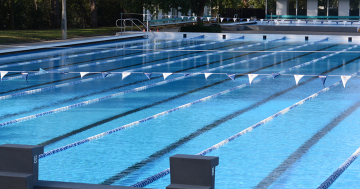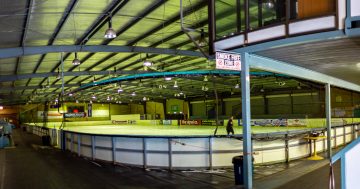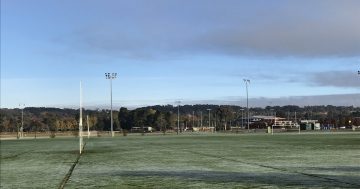
Hawker Tennis Centre. Photos: Tim Gavel.
In the wake of the response to last week’s column about the loss of Canberra sporting facilities, I have been moved to further investigate the changing nature of sporting facilities in our older suburbs.
Last week my focus was the City Bowling Club, which has fallen into disrepair and is now an eyesore as it awaits redevelopment.
Many people wrote to me to tell me about similar problems in their suburbs as sporting facilities, no longer operational, await their fate.

Police Youth Club, Turner.
There were several respondents who inquired about the Turner Police Citizens Youth Club. This building is boarded up still awaiting redevelopment. It has been this way for many years after the PCYC relocated to Charnwood in 2006.

Hawker Tennis Centre.
Another concern was the state of the Hawker Tennis Centre, which ran as a viable operation for many years with Bruce Larkham running the show. The Centre is no longer operating and is now boarded up, also awaiting developers.
The Deakin Bowling Club hasn’t been operating as a club for years and is also fenced off.

Deakin Bowling Club.
One of the reasons why sporting facilities are left in this state for longer than any other redevelopment is the need to change the lease.
I received a number of questions about why many sports grounds are now looking worse for wear. The simple answer is the cost of water, which has made it prohibitive to maintain grounds as they once were.
There is also concern about the fate of existing facilities currently operational but facing an uncertain future.
The Woden Community Council has expressed concern about the future of the Phillip ice rink and pool.

The Philip Swimming Pool underwent refurbishment during the winter months.
It is my understanding that the pool is not financially viable and will become even less so when the new Molonglo Aquatic Centre is built. As such, and with little confidence in the facility generating profits in the future, major upgrades on the Phillip facility are not envisaged.
The ice rink also faces an uncertain future with moves to build a new ice sports complex at Tuggeranong.
The overall cost of running the Phillip ice rink and the pool is high even though the costs are kept as low as possible because of the way ice rinks and pool heating work together.
It still costs about $200,000 in electricity each year.
So what happens to the facility once the Molonglo pool is built and the proposed ice sports centre becomes a reality?
The problem many residents in suburbs with disused sporting facilities face, apart from the loss of the facility in the first place, is the eyesore created by non-operational centres such as bowling clubs and tennis courts.
This can go on for years because of the time it takes to change the lease on sporting facilities for redevelopment as apartments and the like.
Has the time come to move with more speed and efficiency on existing lease changes or will this simply create the environment whereby more sporting facilities become high-rise developments?
















